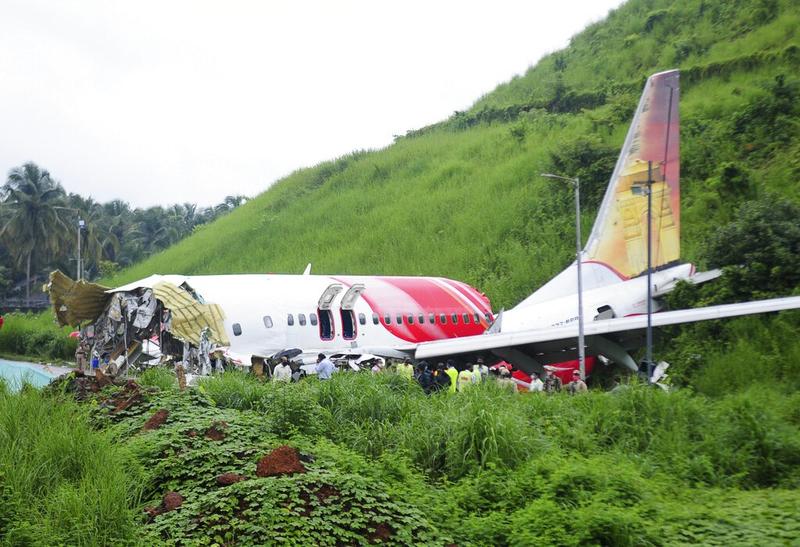 Officials stand on the debris of the Air India Express flight that skidded off a runway while landing in Kozhikode, Kerala state, India, Aug 8, 2020.(C.K. THANSEER/AP)
Officials stand on the debris of the Air India Express flight that skidded off a runway while landing in Kozhikode, Kerala state, India, Aug 8, 2020.(C.K. THANSEER/AP)
Indian authorities ignored at least two recommendations in the past decade to install a safety system on so-called table top runways, one of which an Air India Express jet overshot Friday, killing at least 18 people.
A ground arrestor system, similar to those maintained at Air Force bases, should be installed at table top airports to bring any skidding aircraft to a halt, an investigation report into the 2010 crash of another Air India Express jet recommended
A ground arrestor system, similar to those maintained at Air Force bases, should be installed at table top airports to bring any skidding aircraft to a halt, an investigation report into the 2010 crash of another Air India Express jet recommended.
The runway at Kozhikode, where the latest crash took place, doesn’t have an adequate safety mechanism, especially in wet conditions with a tailwind, a member of the aviation regulator’s Civil Aviation Safety Advisory Council wrote in a letter to top bureaucrats in 2011, a copy of which was seen by Bloomberg News.
READ MORE: Pilot dies after Indian fighter jet crashes in Gujarat
A Boeing Co 737 operating as Flight 1344 from Dubai skidded off the runway after touching down with a tailwind and broke apart while attempting to land Friday, killing at least 18 and injuring more than 100, some of them in critical condition. The black boxes of the plane were found on Saturday.
Most US airports that are built on top of a hill like the one in Kozhikode have installed what are called arresting beds that stop a plane from going off the edge if they can’t stop by the end of the runway.
All flights landing at the runway at Kozhikode “in tailwind condition in rain are endangering the lives of all on board,” Mohan Ranganathan, an aviation safety analyst who advised India’s Directorate General of Civil Aviation, wrote in the 2011 letter. “It is a dangerous situation, especially in wet conditions.”
As recently as 2017, a SpiceJet Ltd-operated Bombardier Inc Q-400 plane, with 75 on board, veered off the same runway and struck the lights at the edge. This incident also happened on a wet runway, according to the final incident report. A year later, airport authorities rejected proposals to implement additional safety measures, citing high operational and maintenance cost, the Hindu newspaper reported citing the airport’s director.
ALSO READ: At least 6 dead as chartered plane crashes in Mumbai
The Kozhikode airport has 240 meters of safety area on both ends, as required by International Civil Aviation Organization regulations, and the airport has been certified, a representative for Airports Authority of India, which runs the facility, said by phone. All mandatory regulations on runway end safety areas were complied with after the DGCA recommendations following the Mangalore crash, he said.
A representative for India’s Aviation Ministry didn’t immediately reply to requests for comment.
The Kozhikode airport is located on a hill with limited space at the end of the runway, and several international airlines had stopped flying bigger aircraft including Boeing 777 and Airbus SE A330 jets into the city due to safety issues. The last fatal plane crash of a commercial jet in India was in 2010, when another Air India Express Boeing plane overshot the runway at Mangalore -- also a table top -- and burst into flames, killing 158 people.


